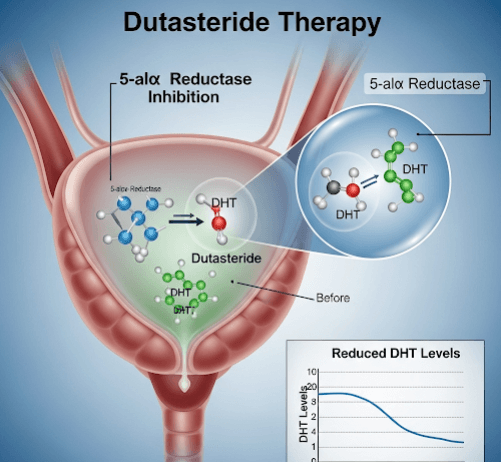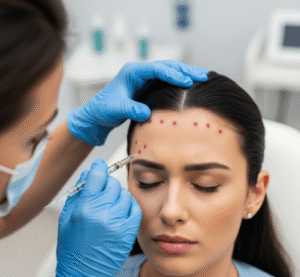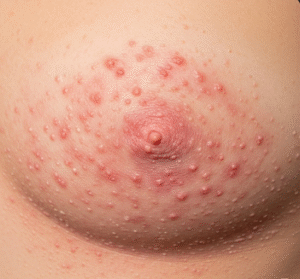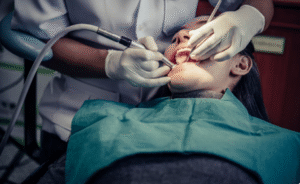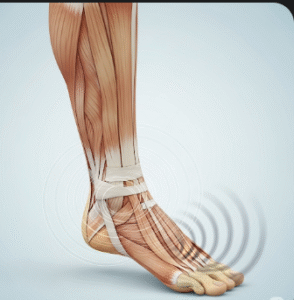🟢 What it is
Dutasteride therapy in Korea is a medical treatment for androgenetic alopecia (pattern hair loss) that works by blocking 5-alpha reductase, the enzyme that converts testosterone into dihydrotestosterone (DHT). DHT is the main hormone responsible for follicle miniaturization and progressive hair thinning.
Unlike finasteride, which blocks only Type II 5-alpha reductase, dutasteride blocks both Type I and Type II, making it 3x more potent in reducing DHT levels. This stronger inhibition makes dutasteride a powerful option in Korean hair loss therapy, especially for men with moderate to advanced androgenetic alopecia.
🟢 Why it’s Done
Patients in Korea use dutasteride therapy because:
➡️ Stronger DHT suppression: Up to 90% reduction (vs. 60–70% with finasteride).
➡️ More effective for advanced hair loss: Helps preserve and reactivate weakened follicles.
➡️ Slows progression: Prevents further miniaturization and baldness.
➡️ Improves density: Increases hair shaft thickness and scalp coverage.
➡️ Alternative to finasteride non-responders: For those who see limited results with finasteride.
It is often called a second-line or stronger upgrade when finasteride alone is insufficient.
🟢 Alternatives
Depending on the case, Korean dermatologists may suggest:
🔹 Finasteride: First-line therapy, milder but proven.
🔹 Topical finasteride/dutasteride: Lower systemic exposure, applied directly to the scalp.
🔹 Minoxidil (oral or topical): Stimulates circulation and hair follicle activity.
🔹 PRP (Platelet-Rich Plasma): Growth factors from patient’s own blood.
🔹 Exosome therapy: Advanced regenerative signals to restore follicle health.
🔹 Regenera Activa: Autologous micro-grafts containing progenitor cells.
🔹 Hair Transplant Surgery: For irreversible follicle loss.
In Korea, dutasteride is often combined with regenerative boosters like PRP or exosomes for stronger outcomes.
🟢 Preparation
Before starting dutasteride therapy:
➡️ Consultation & scalp analysis: To confirm androgenetic alopecia and assess follicle viability.
➡️ Medical history: Patients disclose liver health, prostate issues, and medications.
➡️ Blood work: Sometimes done to monitor liver function and PSA levels.
➡️ Patient selection: Primarily prescribed for men; not typically given to women due to stronger hormonal suppression.
➡️ Expectation setting: Results require 3–6 months, with ongoing use for maintenance.
🟢 How it’s Done
- Dosage: Standard dose for hair loss is 0.5 mg daily.
- Administration: Oral capsule, taken at the same time each day.
- Duration: Long-term therapy; stopping causes reversal within 6–12 months.
- Alternative: Some Korean dermatologists prescribe injectable mesotherapy-style dutasteride (micro-doses delivered into the scalp) for patients concerned about systemic exposure.
🟢 Recovery
Dutasteride therapy requires no downtime, but results take time:
🔹 Initial stage: Some patients may notice temporary increased shedding as new growth cycles begin.
🔹 3–6 months: Reduction in hair shedding becomes noticeable.
🔹 6–12 months: Hair density and shaft thickness visibly improve.
🔹 Ongoing: Results plateau after 12–18 months; maintenance therapy required.
✅ Post-care in Korea includes:
- Dermatologist follow-up every 6–12 months.
- Regular scalp care (scaling, mesotherapy, PRP, or exosome boosters).
- Combination with minoxidil for synergistic effects.
🟢 Complications
Dutasteride is effective but may cause side effects due to its stronger action:
⚠️ Common but mild:
- Decreased libido
- Erectile dysfunction
- Reduced semen volume
⚠️ Less common but possible:
- Gynecomastia (breast tenderness/enlargement)
- Mood changes (depression, anxiety in rare cases)
- Elevated liver enzymes (rare, monitored with blood tests)
➡️ Korean dermatologists carefully evaluate patients before prescribing and may adjust dose or switch to topical dutasteride if systemic side effects are concerning.
🟢 Treatment Options in Korea
Korean clinics use dutasteride in several ways:
🔹 Oral dutasteride: Standard treatment for men with moderate to advanced alopecia.
🔹 Topical dutasteride: For patients wanting lower systemic risk.
🔹 Injectable dutasteride mesotherapy: Micro-injections directly into scalp, increasingly popular in Korea.
🔹 Combination therapies:
- Dutasteride + Minoxidil → Gold-standard combination for maximum preservation and regrowth.
- Dutasteride + PRP / Exosomes → Hormonal control + regenerative stimulation.
- Dutasteride + Hair Transplant → Prevents future loss while transplant restores density.
🟢 Final Thoughts
Dutasteride therapy in Korea is one of the most powerful medical options for androgenetic alopecia. By blocking both forms of 5-alpha reductase, it provides stronger and more consistent results than finasteride, particularly in men with moderate to advanced hair thinning.
➡️ Best for patients who:
- Have not responded well to finasteride
- Show progressive hair loss despite treatment
- Want stronger long-term DHT suppression
➡️ Requires monitoring due to potential side effects, but when managed carefully in Korean clinics, it is both safe and highly effective.
In summary: Dutasteride therapy in Korea is a potent, scientifically proven, and long-term solution for male pattern baldness, especially when combined with regenerative injectables and modern hair restoration protocols.

